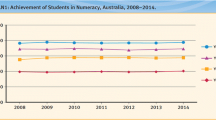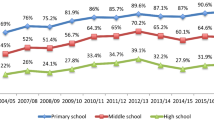Abstract
According to international studies of achievement in mathematics amongst Australian secondary school students, results have declined over time when compared with other countries. The National Assessment Program – Literacy and Numeracy (NAPLAN) is an Australian government initiative to measure whether students have the knowledge, understanding, skills and values required for a productive and rewarding life. This paper presents a case study of a school with improved NAPLAN numeracy results to provide insights into factors that influenced student performance. The findings are structured according to themes evident in the data. The discussion explores these themes in relation to Hattie’s areas of influence on success in students’ learning: the school, the student, the home, the curriculum, the teacher, and the approaches to teaching. Through the analysis of data collected from a variety of stakeholders in the school, this case study highlights the importance of school-wide policies towards learning mathematics and adopting effective approaches to teaching it. These insights have implications for teachers, school leaders and systems who are working towards improving numeracy results.

Similar content being viewed by others
Notes
Pseudonym
References
ACARA (2013). Submission from the Australian Curriculum, Assessment and Reporting Authority Retrieved from http://www.aph.gov.au/Parliamentary_Business/Committees/Senate/Education_and_Employment/Naplan13/Submissions.
ACARA (2019). MySchool. Retrieved from http://www.myschool.edu.au/.
Attard, C. (2013). “If I had to pick any subject, it wouldn’t be maths”: foundations for engagement with mathematics during the middle years. Mathematics Education Research Journal, 25(4), 569–587.
Australian Curriculum, Assessment and Reporting Authority [ACARA] (2016). National Assessment Program. Retrieved from https://www.nap.edu.au/.
Ball, D. L., Thames, M. H., & Phelps, G. (2008). Content knowledge for teaching. Journal of Teacher Education, 59(5), 389–407.
Baxter, P., & Jack, S. (2008). Qualitative case study methodology: study design and implementation for novice researchers. The Qualitative Report, 13(4), 544–559.
Beswick, K. (2003). Accounting for the contextual nature of teachers' beliefs in considering their relationship to practice. In Mathematics education research: Innovation, networking, opportunity, 1, 152–159.
Beswick, K. (2005). The beliefs/practice connection in broadly defined contexts. Mathematics Education Research Journal, 17(2), 39–68.
Beswick, K. (2012). Teachers’ beliefs about school mathematics and mathematician’s mathematics and their relationship to practice. Educational Studies in Mathematics, 79, 127–147.
Brown, M., Brown, P., & Bibby, T. (2008). “I would rather die”: reasons given by 16-year-olds for not continuing their study of mathematics. Research in Mathematics Education, 10(1), 3–18.
Callingham, R., Beswick, K., Carmichael, C., Geiger, V., Goos, M., Hurrell, D., Hurst, C., & Muir, T. (2016). Nothing left to chance: characteristics of schools successful in mathematics. (Report of the building an evidence base for best practice in mathematics education project). Hobart: University of Tasmania.
Caputo, A., & Rastelli, V. (2014). School improvement plans and student achievement: preliminary evidence from the Quality and Merit Project in Italy. Improving Schools, 17(1), 72–98.
Carmichael, C., Callingham, R., & Watt, H. M. G. (2017). Classroom motivational environment influence on emotional and cognitive dimensions of student interest in mathematics. ZDM Mathematics Education, 49, 449–460.
Chick, H., & Pierce, R. (2013). The statistical literacy needed to interpret school assessment data. Mathematics Teacher Education and Development, 15(2), 5–26.
Chubb, I. (2013). Mathematics, engineering & science in the national interest: a strategic approach: a position paper. (ISBN 978 1 821916 95 3). Canberra: Commonwealth of Australia. Commonwealth of Australia. (2011). Skill Shortages Australia. Retrieved from http://www.deewr.gov.au/Employment/LMI/SkillShortages/Documents/NationalSkillShortagesReport_Dec2011.pdf.
Clarke, D. J. (2011). Open-ended tasks and assessment: the nettle or the rose. In B. Kaur & K. Y. Wong (Eds.), Assessment in the mathematics classroom yearbook 2011 (pp. 131–163). Singapore: World Scientific Publishing.
Clarke, D. J., Clarke, D. M., & Sullivan, P. (2012). How do mathematics teachers decide what to teach? Australian teachers. Australian Primary Mathematics Classroom, 17(3), 9–12.
Datnow, A., Borman, G., & Stringfield, S. (2000). School reform through a highly specified curriculum: implementation and effects of the core knowledge sequence. The Elementary School Journal, 101(2), 167–191.
Dweck, C. (2006). Mindset: the new psychology of success. New York: Random House.
Dweck, C. (2017). Mindset: changing the way you think to fulfil your potential. UK: Hachette.
Fennema, E., & Sherman, J. A. (1976). Fennema-Sherman mathematics attitudes scales: instruments designed to measure attitudes toward the learning of mathematics by females and males. Journal for Research in Mathematics Education, 7(5), 324–326.
Forgasz, H., & Leder, L. (2008). Beliefs about mathematics and mathematics teaching. In P. Sullivan & T. Wood (Eds.), Knowledge and beliefs in mathematics teaching and teaching development (pp. 173–194). Rotterdam: Sense Publishers.
Franke, A., & Dahlgren, L. O. (1996). Conceptions of mentoring: an empirical study of conceptions of mentoring during the school-based teacher education. Teaching and Teacher Education, 12(6), 627–641.
Fuller, A. (2001). Creating resilient learners. Learning Matters, 6(3), 22–25.
Goodrum, D., Druhan, A., & Abbs, J. (2012). The status and quality of year 11 and 12 science in Australian schools. Australian Academy of Science: Prepared for the Office of the Chief Scientist.
Goos, M., Dole, S., & Makar, K. (2007). Designing professional development to support teachers’ learning in complex environments. Mathematics Teacher Education and Development, 8(2), 23–47.
Grootenboer, P., Edwards-Groves, C., & Rönnerman, K. (2015). The practice of “middle leading” in mathematics education. In M. Marshman, V. Geiger, & A. Bennison (Eds.), Mathematics education in the margins (Proceedings of the 38th annual conference of the Mathematics Education Research Group of Australasia, pp. 277–284). Sunshine Coast: MERGA.
Hattie, J. A. C. (2009). Visible learning. A synthesis of over 800 meta-analyses relating to achievement. Abingdon: Routledge.
Henman, P., & Gable, A. (2015). “Schooling” performance measurement: the politics of governing teacher conduct in Australia. Policy and Society, 34, 63–74.
Howell, J. M., & Higgins, C. A. (1990). Champions of change: identifying, understanding, and supporting champions of technological innovations. Organizational Dynamics, 19(1), 40–55.
Leiringer, R., & Cardellino, P. (2008). Tales of the expected: investigating the rhetorical strategies of innovation champions. Construction Management and Economics, 26(10), 1043–1054.
Ma, L. (1999). Knowing and teaching elementary school mathematics. Mahwah: Lawrence Erlbaum Associates.
MacDonald, B., & Walker, R. (1975). Case study and the philosophy of educational research. Cambridge Journal of Education, 5(1), 2–10.
Martin, A. J. (2003). The student motivation scale: further testing of an instrument that measures school students’ motivation. Australian Journal of Education, 47(1), 88–106.
Masters, G. N. (2010). Teaching and learning school improvement framework. Retrieved from: http://research.acer.edu.au/cgi/viewcontent.cgi?article=1015&context=monitoring_learning. Accessed 23 Jan 2018.
Merriam, S. B. (1988). Case study research in education: a qualitative approach. Jossey-Bass.
Meyer, C. B. (2001). A case in case study methodology. Field Methods, 13(4), 329–352 Associates.
Miles, M. B., Huberman, A. M., & Saldana, J. (2014). Qualitative data analysis: a method sourcebook. CA: Sage Publications.
Mockler, N. (2013). Reporting the ‘education revolution’: MySchool.edu.au in the print media. Discourse: Studies in the Cultural Politics of Education, 34(1), 1–16.
Muir, T., Livy, S., Herbert, S., & Callingham, R. (2018). School leaders’ identification of school level and teacher practices that influence school improvement in national numeracy testing outcomes. Australian Educational Researcher, 45(3), 297–313.
Mullis, I. V., Martin, M. O., Foy, P., & Hooper, M. (2016). TIMSS 2015 international results in mathematics. TIMSS & PIRLS International Study Center at Boston College.
Obara, S. (2010). Mathematics coaching: a new kind of professional development. Teacher Development, 14(2), 241–251.
Pietilla, A. (2003). Fulfilling the criteria for good mathematics teacher—the case of one student. Proceedings of European Research in Mathematics Education III. Retrieved from http://www.dm.unipi.it/clusterpages/didattica/CERME3/proceedings/Groups/TG2/TG2_pietila_cerme3.pdf. Accessed 16 Mar 2018.
Rice, J. K. (2003). Teacher quality: understanding the effectiveness of teacher attributes. Economic Policy Institute, 1660 L Street, NW, Suite 1200, Washington, DC.
Rittle-Johnson, B., Siegler, R. S., & Alibali, M. W. (2001). Developing conceptual understanding and procedural skill in mathematics: an iterative process. Journal of Educational Psychology, 93(2), 346.
Schoenfeld, A. H. (2004). The maths wars. Educational Policy, 18(1), 253–286.
Smith, P., Ladewig, M. & Prinsley, R. (2018). Improving the mathematics performance of Australia’s students. Retrieved from https://www.chiefscientist.gov.au/2018/07/occasional-paper-improving-the-mathematics-performance-of-australias-students/. Accessed 6 Oct 2018.
Song, I. S., & Hattie, J. (1984). Home environment, self-concept, and academic achievement: a causal modeling approach. Journal of Educational Psychology, 76(6), 1269–1281.
Stipek, D. J., Givvin, K. B., Salmon, J. M., & MacGyvers, V. L. (2001). Teachers’ beliefs and practices related to mathematics instruction. Teaching and Teacher Education, 17, 213–226.
Thomson, S., De Bortoli, L., & Underwood, C. (2016). PISA 2015: a first look at Australia’s results. Camberwell: Australian Council for Educational Research.
Williams, G. (2014). Optimistic problem-solving activity: enacting confidence, persistence, and perseverance. ZDM, 46(3), 407–422.
Wilson, R. Dalton, B., & Baumann, C. (2015). Six ways Australian’s education system is failing our kids. Retrieved from http://theconversation.com/six-ways-australias-education-system-is-failing-our-kids-32958. Accessed 6 Oct 2017.
Yin, R. K. (2006). Case study methods. In J. L. Green, G. Camilli, & P. B. Elmore (Eds.), Handbook of complementary methods in education research (pp. 111–122). Mahwah: Lawrence Erlbaum.
Author information
Authors and Affiliations
Corresponding author
Additional information
Publisher’s note
Springer Nature remains neutral with regard to jurisdictional claims in published maps and institutional affiliations.
Rights and permissions
About this article
Cite this article
Herbert, S., Muir, T. & Livy, S. Characteristics of a secondary school with improved NAPLAN results. Math Ed Res J 32, 387–410 (2020). https://doi.org/10.1007/s13394-019-00304-y
Received:
Revised:
Accepted:
Published:
Issue Date:
DOI: https://doi.org/10.1007/s13394-019-00304-y




